Marketing funnels differ from sales funnels because they aren’t primarily created to increase sales. Instead, a marketing funnel is used to get potential customers onto your site. But how do you design a marketing funnel that works?
The first step in designing a marketing funnel is figuring out the results you want from it. Defining your goals, considering your customer’s journey, creating funnel flowcharts, and strategizing content placement are all steps that will help you create a successful marketing funnel.
If you have a business or are planning a product launch, you’ll need a good marketing funnel to gain attention. Everything starts small, so we’ll walk you through all the details of designing an effective marketing funnel.
Steps To Designing A Result Oriented Marketing Funnel
1. Define Your Goals
To begin with, you should know exactly what kind of result you want from your funnel. Do you want more traffic or better conversions? More leads or more sales?
For example, if you run a photography studio, you may want to focus on generating more leads.
This means more people who are interested enough to click through to your site or sign up for your newsletter. From there, you can leverage their interest to get them to book a session or buy a product.
On the other hand, if you run a consulting company, you might be trying to generate more sales leads. These leads could be people who have been referred to your services by family members or friends.
You also might need to deal with potential clients who are looking for a specialized service. The only way to get good results is to clearly define your goals before you begin.
Without a goal, it will be difficult to measure the success of your funnel.
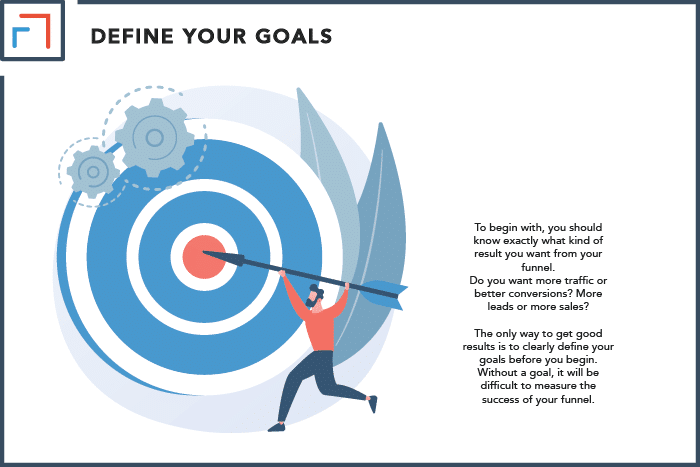
2. Consider Your Customer’s Journey
When designing a funnel, you need to consider every aspect of your customer’s journey. That can be overwhelming, but you can start small!
To begin, focus on the big picture and plan out a general flow of activities that lead people through your funnel from start to finish. To do this, consider your company goals and how you’d like to achieve them.
Think about how you’ll accomplish this goal – whether that means making a product or service better, increasing revenue, or finding new customers.
Then, break down the main stages of your funnel into smaller segments.
For example, if you sell shoes and you want to increase sales by driving more traffic to your website, you could separate the stages of your funnel into the following categories:
- Attracting new customers with email marketing
- Up-selling more expensive products with social media
- Offering special deals through coupons or promotional codes
- Converting new customers into long-term buyers with phone support and in-store assistance.
As a rule of thumb, when starting with a new marketing funnel, you should ask yourself these questions:
- What do my prospects want?
- Who am I targeting?
- What problems are they facing?
- Where do they come from?
Once you answer those questions, you’ll have a good platform of knowledge to build off of. You’ll also get an image of your ideal customer and have some reasons for why they should buy from you.
Pro Tips
Once you’ve identified the key stages of your funnel, identify the actions that can be taken during each stage.
For example, while email marketing may seem obvious, you also might want to run some Facebook ads because these can effectively attract potential customers.
When identifying necessary actions, be sure to look at the end result of those actions. Does the action provide enough value to justify taking it?
Or is it just something you’re doing because it’s part of your overall strategy? When looking at the end result, ask yourself if there’s any way you can improve the current action.
Finally, consider the number of people who can benefit from the action.
This number depends on the value of the action, so if you can offer a high-quality experience to a large group of people, you should do so.
On the other hand, if the action only benefits a small portion of your target market, it’s best to avoid it and review alternative options.
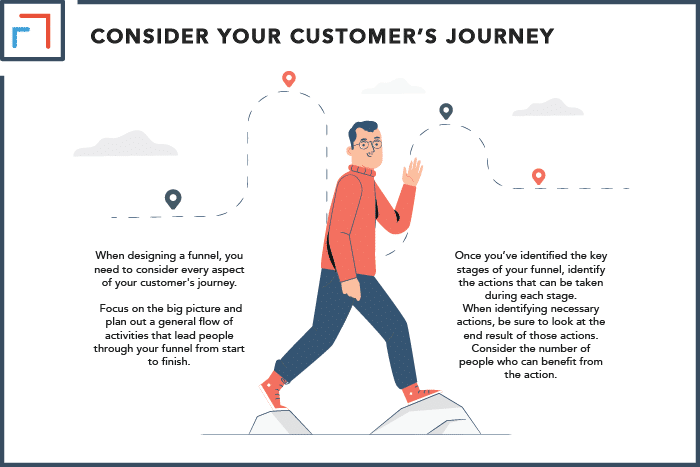
3. Create a Flowchart of the Funnel
A flowchart is one of the best tools for visualizing the flow of a process. A flowchart helps you break down the stages of the process into individual, numbered boxes.
This makes it easier to identify where each box belongs and ensures that the order of operations is correct. To create a flowchart of your funnel, start by identifying the main stages of the process.
Then, break down each stage into smaller steps. For each step, create a box and label it with the corresponding number.
Once you know exactly where each box should go, you can start designing the shape of the funnel itself. The exact form doesn’t matter much.
All that matters is that it has enough room to fit the number of people who enter the funnel at each stage.
A Visual Representation of Funnel Flowcharts
Here’s an example of a basic funnel flowchart: (For Designer: Please create an illustration of the text below) The illustration above shows the stages of a typical sales funnel.
As you can see, the funnel starts with attracting new customers. Once you have a customer’s attention, you need to convert them into a paying customer.
To do this, you must offer them a product or service that they actually need/want. Once the lead pays for the product or service, they become your customer.
From there, you can upsell more expensive products to them, offer discounts on future purchases, or provide them with excellent customer service that encourages them to return again.
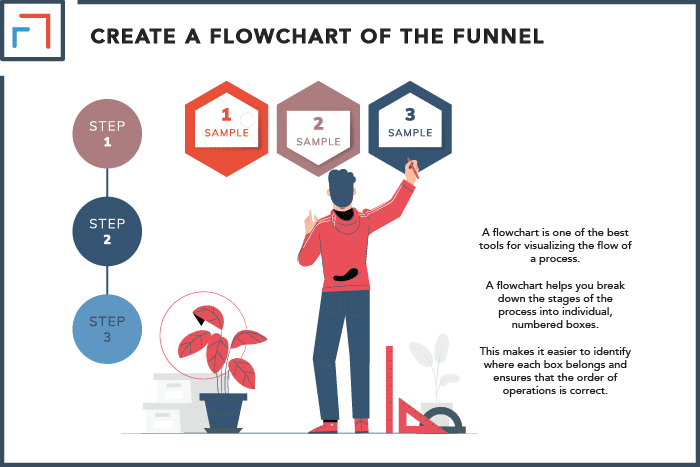
4. Flesh Out Each Stage of the Funnel
Now that you’ve got your funnel designed and set up, it’s time to add some meat to those bones. The following sections cover the four funnel stages and the content you should create for each step.
Stage 1: Attention
The first stage of the funnel is all about getting attention. You need to find a way to grab the attention of your target audience and get them interested in what you have to say.
There are a few different ways you can do this, but some of the most effective methods include:
- Creating informative blog posts that answer your target audience’s questions
- Using social media to share interesting or valuable content
- Running ads that attract your target audience
- Creating helpful resources, such as ebooks or guides
- Participating in relevant online communities
If you can get your target audience’s attention, you’ll be able to move them to the next stage of the funnel.
Stage 2: Interest
Once you have the attention of your target audience, it’s time to start building their interest. You need to take the information you shared in the first stage and use it to pique your target audience’s interest.
Most people won’t be interested in your product or service right away. They’ll need to see that it can offer them value before they’re willing to take action.
Let’s take a look at some of the most effective methods to do this:
- Using case studies or customer testimonials to show how your product or service has helped others in the past
- Sharing detailed information about your product or service to show how it can benefit your target audience
- Showcasing social proof, such as celebrity endorsements or awards, to show that others trust your product or service
Recall that you’re planning your sales funnel, and your main goal here is to fill the marketing funnel with as many leads as possible.
Stage 3: Decision
The third stage of the funnel is all about helping your target audience make a decision. At this point, they should be interested in your product or service.
But they still need a little more information before they’re ready to take the desired action. This is where you need to close the deal.
You need to convince your target audience that your product or service is the best solution for their needs. To do this, you can:
- Use pricing pages to show how your product or service compares to similar products or services on the market
- Offer free trials or coupons to help your target audience make a decision
- Create detailed product or service pages that highlight the features and benefits of your offering
If you can successfully close the deal at this stage, you’ll have a paying customer! But your work isn’t done yet.
Step 4: Action
Often, the fourth stage of the funnel is where businesses achieve their goals. Ideally, this is the point at which your target audience takes the desired action.
This is where you need to provide visitors with a clear call to action (CTA). A CTA is a specific instruction that tells your target audience what they need to do next.
Your CTA should be clear, concise, and easy to follow. It should also be relevant to the stage of the funnel your target audience is in. Some examples of effective CTAs include:
- Download our free ebook to learn more about our product!
- Sign up for our newsletter to get the latest news and updates.
- Visit our website to learn more about our products and services.
- Call us today to speak to one of our sales representatives!
Your CTA will vary depending on your goal, product/service, and the stage of the funnel your target audience is in.
But as long as it’s clear and relevant, it should help move your target audience towards conversion.
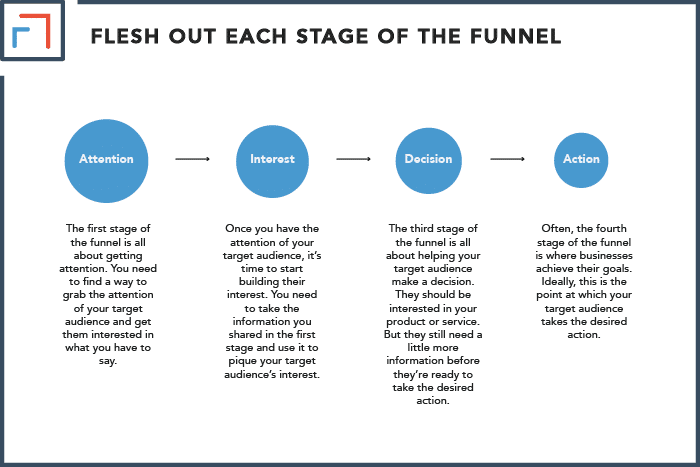
Funnel Design Tips
The overall performance of your funnel will also depend on how well it’s designed.
While most people are able to get the basics right, there are a few key design elements that can make a big difference in your marketing funnel’s performance. Let’s take a look at some of these.
1. Mockups
Mockups are visualizations of your marketing funnel. They are usually simplified and designed with shapes and symbols. Mockups show you how different elements work together on a web page.
You’ll probably start off by sketching out some ideas in a notebook or using a program like Adobe Illustrator or Photoshop.
From there, follow the guidelines you have set for how your funnel should look and feel. Finally, you can build the mockup based on that.
As you move through the stages of your funnel, add more shapes and icons to give it a better visual language.
For example, if you were working on a product landing page, you may decide to include a call-to-action button within the funnel itself.
Once your user clicks on the button, they will be taken to an internal page where they can complete their purchase.
When everything is set up, start creating your real content based on the mockup. Keep your eyes open for any potential bugs or errors, such as missing text or images.
Once you’ve finished designing your funnel, you’ll need to share it with others to get outside feedback and find out what works best. Be sure to keep notes about each version as well.
2. Symbols & Icons
Next, you must add symbols and icons to help guide your users through the funnel. There are a few different ways to do this.
You can use traditional shapes like rectangles and arrows or more modern icons like user flows and conversion paths. If you decide to use arrows, make sure they’re big and bold so they’re easy to see.
You should also place them in strategic positions. That way, they guide your users’ eyes to where you want them to look.
For example, if you want your users to focus on a particular call-to-action button, you might place an arrow next to it.
As for icons, they can help add more visual interest to your funnel and make it more engaging. However, you should use them sparingly, as too many icons can make your funnel look cluttered and confusing.
Lastly, when choosing symbols and icons, ensure they’re high quality and consistent with your brand’s overall aesthetic.
3. Bullet Points
Bullet points are a visual way to break up long text. They also make written material easier to read.
The point of using bullets is not to replace words with symbols but to present ideas visually so that readers can focus on the most important items.
When writing bullet points, keep in mind these three points that you should aim for:
- Actionable – The bullet point should be something that can be done. For example, “Download our app.”
- Immediate – The bullet point should be something that can be done immediately. For example, “Sign up for our newsletter”.
- Visual – The bullet point should be something that can be seen. For example, “View our portfolio.”
Once you’ve decided on the purpose of your bullet points, you can start writing them out. Remember to keep them short and to the point; otherwise, they will lose their impact.
If you’re having trouble coming up with ideas, try looking at marketing funnels that other people in your industry use for inspiration. Chances are, they’ll have some great ideas that you can adapt to your needs.
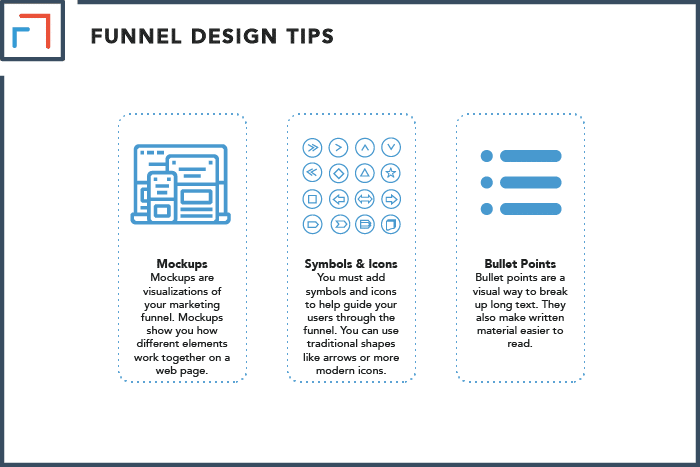
Final Thoughts
Designing an effective marketing funnel requires careful planning and execution. By following the steps outlined in this article, you can create a funnel that is both functional and visually appealing.
Don’t forget to test your funnel before you launch it. That way, you can get feedback from others.
With a little bit of effort, you can create a powerful marketing tool that will help you increase leads and conversions.
Remember that it may seem like a lot of work at first, but after you get started, you’ll find that designing a marketing funnel isn’t as difficult as you thought it would be.
